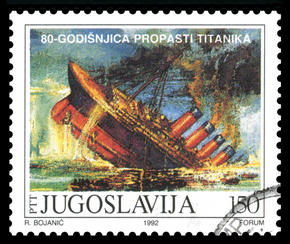
After greater than a century, the fascination of the Titanic’s maiden voyage and sinking stays. With artifacts being exhibited across the nation, the blockbuster film rereleased in 3D, and a Titanic II being constructed with a scheduled maiden voyage deliberate for 2016, the story nonetheless slakes our thirst for love and tragedy. Once you add the ghostly photographs from the North Atlantic and man’s potential to reclaim treasure from the seafloor, the Titanic’s magnetizing impact appears almost unbreakable. As a narrative from historical past, Titanic will seize your college students’ curiosity. Nevertheless, to maximise the time spent on the subject, think about a number of science investigations to discover one other side of this tragedy.
How the Titanic was Totally different
The unique motive for billing the ship as unsinkable got here from the design of its watertight compartments. Three compartments may fill with water, however the ship may stay afloat. To show this, have pupils gather empty milk cartons from the cafeteria. Every mannequin ship would require six empty cartons:
- Seal every milk carton shut.
- Bind the six sealed cartons along with scorching glue in a three-by-two array. It could be useful to make 3 fashions for a complete of 18 cartons.
- Now make a fourth, barely completely different mannequin from a quart-sized milk carton and seal it with scorching glue just like the others.
- Connect a shoe field lid to the the highest of every of the 4 fashions.
- Let the youngsters add individuals, furnishings, and props to intensify the drama when the boat sinks.
Dialogue Query:
- What are the variations within the two distinctive designs? (One giant compartment versus a number of, smaller watertight compartments)
- How may these variations have an effect on sinking?
Lower a gap within the quart mannequin and a gap in a single carton of multi-carton ship mannequin. Report the time they take to fill with water. Repeat with the opposite ships, however minimize holes in two of the cartons on ship two, and minimize holes in three of the cartons on the third mannequin. Will including extra watertight compartments change the result? Titanic really had sixteen compartments. If time permits, let youngsters experiment to see if they’ll recreate Titanic’s three-hour sinking.
The Position of Water Stress
Kids could surprise how an unsinkable ship may slip under the water in such a short while (about three hours). One technique to show the impact of water strain on sinking time is to make use of a five-gallon bucket. Earlier than class, punch three holes within the bucket with a hammer and a thick nail, or screwdriver. One gap ought to be one inch from the underside of the bucket. This gap represents twenty ft under sea degree which is the depth at which the iceberg punctured the hull. Punch the opposite two holes at 5 inches and 9 inches. Cowl the holes with sturdy tape.
College students ought to predict what is going to occur when the tape is eliminated:
- Will water keep within the bucket?
- Will it shoot an equal distance from all of the holes?
It could be finest to take this experiment outdoors because of the quantity of water. In any other case, you will have to have a big sink or basin useful. It’s essential that the bucket be elevated a number of ft off the bottom. Fill it utilizing both a second five-gallon bucket or a hose. Clarify to college students that the bucket of water represents the ocean and the remainder of the room is the ship. The holes characterize the punctures made into Titanic’s hull so they’re really observing the water because it rushed into the ship. Take away the tape and observe. How do they assume water strain affected the sinking time?
To Rust or To not Rust
Even earlier than the doomed ship reached the ocean backside, salt water was working to degrade the ship’s hull. Titanic sat in ocean water for a full yr earlier than it set sail, which some imagine weakened the kind of rivets used to carry her collectively. Your class can discover how salt water weakens various kinds of metals.
An empty fish aquarium works effectively for this investigation, however a clear bucket will do. You will have the next provides:
- Kosher salt.
- Iron nails.
- Equal lengths of copper, galvanized metal, and aluminum wire.
For every gallon of water, add 4.5 ounces of salt, a few half cup. As an extension, you too can arrange one other investigation with recent water.
Wrap the wires round glass-stirring rods, leaving a number of inches hanging off. Repeat utilizing the nails rather than the rods; decrease them into the water. Every day, take away the wires and have pupils tug firmly to test for weakening. Observe every other modifications. Is there any distinction between the wires wrapped across the rods versus the nails? What may this characterize? Be aware: Titanic’s hull was made from a distinct form of metallic than the rivets used to carry the hull plates collectively. Metals surrender their electrons at completely different charges in a course of known as galvanic alternate. Secondary college students can add this to their investigation.
For many, the tragedy of Titanic’s sinking is a historic human curiosity story. For scientists, it affords numerous alternatives in scientific investigation.
Go to Lesson Planet for Extra Concepts about Titanic’s Voyage and Sinking:
Six Methods to Educate concerning the Titanic Catastrophe
This text suggests cross curricular concepts to review the Titanic from a number of angles. Analysis abilities are emphasised in addition to information evaluation and writing. Most actions could be tailored for fourth grade and up.
What’s Consuming Titanic?
This lesson for secondary learners focuses on biodeterioration processes under the ocean floor. It focuses on the impact of rust-eating microbes discovered within the ship’s stays and purposes for the data that scientists are gleaning it.
Titanic Tales
An in-depth useful resource from Texas Devices requires the usage of calculators and familiarity with the perform keys. Actions give attention to studying and deciphering graphs and charts and making comparisons between information units. Pupils additionally decide whether or not the info is deceptive.

